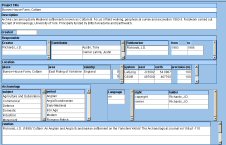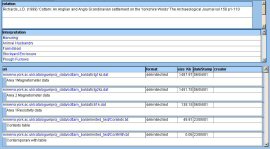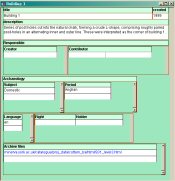
Figure 8: Screenshot showing front page of layered metadata record for Burrow House Farm, Cottam excavation (Click thumbnail to expand)
The ARENA project made a variety of data available online. This included specific site-based fieldwork and excavation archives as well as monument record index level data. To make sites and monuments index data searchable, the data need to comply with a standard that allows the search portal to recognise and arrange search results. In other words a metadata standard is required; in the case of the ARENA project the Dublin Core standard was selected. This was chosen because as well as being recognised as an international resource discovery metadata standard (Wise and Miller 1997) the Z39.50 and OAI technologies to be used in interoperable searching are Dublin Core compliant. These issues are discussed by Dam and Hansen. Dublin Core (DC) metadata is therefore used in the ARENA portal to allow the ARENA partners to map their individual Sites and Monuments indices to a single interoperable searchable index.
In addition to the use of Dublin Core metadata to facilitate searching sites and monuments index data in the ARENA portal, a data structure was designed to permit the application of the same search facility across individual site archives, linking the publication to the archive through metadata indexing. The idea of 'layered metadata' is an extension of the concept of using DC to create an index, but in this case the index sits in an 'Interpretation layer' between the basic DC description or 'Project layer' and an 'Archive layer' made up of file level DC metadata describing specific elements within the archive.
The index in the 'Interpretation layer' is the key to the concept. The 'Project layer' and the file level 'Archive layer' metadata records are commonly used to index archives by organisations such as the Archaeology Data Service. The 'Interpretation layer' index creates an intermediate layer of metadata that describes interpretations or ideas. The creation of metadata for concepts or ideas (interpretations of archaeological data) has its roots in the early work of CIDOC and MIDAS.
An index of interpretations and ideas requires the active extraction of interpretative statements from publications or particular sections of an archive. These concepts are each given their own DC metadata record. The DC_Subject element (named interpretation/Archive on the data structure in Figure 7) allows these interpretations to be assigned to thematic terms held in a controlled vocabulary. In this case the themes are drawn from the MIDAS Thesaurus of Monument Types (NMR:TMT) and a set of six archaeological investigation types. This use of DC_Subject allows the index to be searched thematically as well as by period.
Layered Dublin Core metadata uses the DC_Relation and DC_Source fields to act as connections between the layers, particularly for the 'Interpretation layer'. The interpretations selected and entered into the 'Interpretation layer' are linked to the evidence (held in the 'Archive layer') cited in the excavation report.
The elements within the data structure are all related to Dublin Core elements, which allows the database to comply with standards in archiving digital data and can for example be mapped into other systems of data structure such as the CIDOC Conceptual Reference Model.
The data structure shown in Figure 7 allows searching by theme. A demonstrator of the concept built in Microsoft Access allows the user to view links to themes from the excavations at Burrow House Farm, Cottam, East Yorkshire. The interpretative themes are manuring, animal husbandry, farmstead, stockyard enclosure, plough furrows, farming settlement, estate reorganisation, ladder settlement, farm enclosures, farmstead, fenced enclosure, animal production and consumption, hunting, cereal crop production, coin usage, building 1, trackway and building 3.
The screen shot (Figure 8) shows the front page of the layered metadata demonstrator, containing the upper level 'Project layer' metadata.

Figure 8: Screenshot showing front page of layered metadata record for Burrow House Farm, Cottam excavation (Click thumbnail to expand)
By scrolling down through the Project layer the user will find a list of interpretations drawn from the publication of the project (see Figure 9). In the case of the Cottam project this is an article published by J.D. Richards in 1999; Cottam: An Anglian and Anglo-Scandinavian settlement on the Yorkshire Wolds, published in the Archaeological Journal 156 and Internet Archaeology Issue 10

Figure 9: Screenshot showing front page of layered metadata record for Burrow House Farm, Cottam excavation. In particular the links to 'Interpretation layer' and 'Archive layer' (Click thumbnail to expand)
When a user clicks on one of the listed interpretations they are taken to the 'Interpretation layer' metadata for that interpretation (see Figure 10). For example, the screen shot in Figure 10 shows the metadata for the interpretation of a set of post-holes as building 1. This interpretation is then linked to the digital archive held by the Archaeology Data Service, recorded by metadata at the 'Archive layer'. Through this link the user can access the digital data relating to building 1.

Figure 10: Screenshot showing 'Interpretation layer' for building 1 at Burrow House Farm, Cottam (Click thumbnail to expand)
The linkage of interpretation to data is an important issue for archaeology that will be addressed in the future through digital technologies, data standards (such as metadata) and electronic publication. The ARENA project only had the resources to undertake a preliminary investigation of the use of layered metadata to allow users to search for related concepts across a number of archives. Future electronic publication will allow the kind of linkages made by the ARENA metadata demonstrator to be made from interpretations made in electronic format. A further step in linking interpretation and supporting data is being made by the LEAP project, a partnership between the Archaeology Data Service as archivists and Internet Archaeology as electronic publisher.
© Internet Archaeology/Author(s)
University of York legal statements | Terms and Conditions
| File last updated: Tue Sep 27 2005